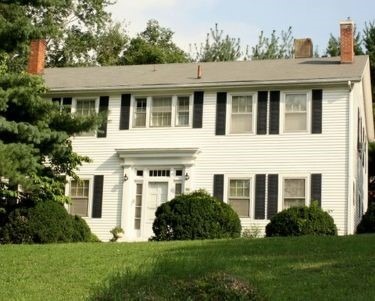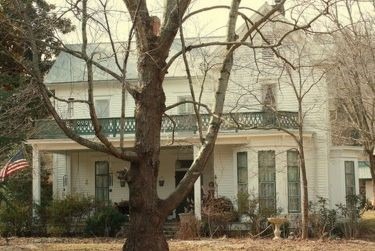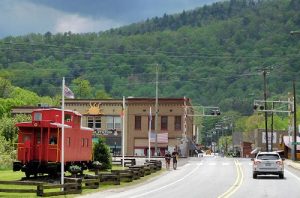Hot Springs, Nc
A captivating journey through time
Embark on a captivating journey through time with our self-guided walking tour of Hot Springs, NC. Stroll down picturesque streets lined with architectural gems, each whispering tales of the town’s vibrant past.
As you walk, keep an eye out for unique architectural styles, like the Italianate Victorian grandeur of the Sunnybank Inn, a former haven for famous ballad singers. This tour is perfect for history buffs and anyone who loves a good story. So lace up your walking shoes, grab your camera, and get ready to discover the magic of Hot Springs, NC, one historic stop at a time.

1. Washburn Cottage
29 Walnut St
WASHBURN COTTAGE was built in 1924 at a cost of $11,000. The house served as a practice cottage and dormitory for senior girls at Dorland-Bell Institute which was founded as Dorland Institute in 1887 by Dr. and Mrs. Luke Dorland and was taken over by Presbyterian Church U.S.A. in 1893. It became Dor-land-Bell Institute in 1918 when consolidated with Bell Institute from Jewell Hill. Moved to Asheville in 1942 as part of Warren-Wilson College

2. Sunnybank Inn
149 26 Walnut St
SUNNYBANK INN AND RETREAT dates from 1840 and is a rare example of Italianate Victorian architecture. It was the home of ballad singers Jane Gentry and Maude Long in the early 1900s. The building has served as a private home, boarding house, hiker hostel, and retreat center. In 1980 it was placed in the National Register of Historic Places in recognition of its significant role in American history, architecture, and culture.

3. Rufty House
46 Frisbee St
The RUFTY HOUSE was built in about 1913 by a local carpenter, Dave Melton, for the Thomas Rufty family who were renting the Sunnybank House next door. Dr. Edward Peck, beloved town doctor, was also living at Sunnybank and rented an upstairs room in the Rufty House. The present owners (since 1971), have maintained and remodeled the house to keep with the integrity and character of the original design.

4. Lippard House
112 Walnut St
The LIPPARD HOUSE, another grand 1870s house, has always been a private residence. The gazebo in the yard was built by Germans interned in Hot Springs during World War I

5. Burgin House
82 Hill St
The BURGIN HOUSE, built in 1917 for the W. W. McFall family, was acquired in 1920 by the Burgin family. Mrs. Myrtle Burgin added a sun porch and an upstairs bath to the original structure which featured four downstairs and two upstairs rooms. Its signature architectural feature is its broad front porch which has provided a wonderful place for relaxing and visiting during its long history

6. Gentry Hardware
124 Bridge St
GENTRY HARDWARE was built by the Gentry family in 1946 and has remained in continuous use as a hardware store ever since. Third generation owner, Keith Gentry runs the store today, taking over from his parents, James and Dot. The building was constructed by James and his father of fieldstone brought over from Tennessee. It features all the original architecture and the wooden floors are from the former Dorland-Bell girls’ dormitories.

7. South Andrews Ave Corner
Corner Andrews & Bridge St
The SOUTH ANDREWS AVENUE CORNER, boasts a complex of three historic buildings. The Iron Horse Station is a landmark inn, restaurant, tavern, and shop. The Hot Springs City Hall building is sandwiched between one of the oldest (1860) standing brick buildings in Madison County and an intact 1890s Rooming and Boarding House converted into a 15-room Inn.

8. Hot Springs Historic Marker
Hwy 25/70 on Hot Springs Spa Property
Hot Springs has been a destination for those seeking the benefits of its world famous natural hot mineral springs for200 years. The Mountain Park Hotel was the property‘s most famous historical hotel attracting the rich and famous. O’Henry spent his honeymoon here in 1907.
It burned in 1920 and its replacement burned fifty years later. This is now the site of the Hot Springs Resort and Spa which continues to use the natural hot mineral water.
The U.S. government leased the property during World War I as an internment camp for German
prisoners.

9. Paint Rock Historic Marker
Hwy 25/70 & River Road
PAINT ROCK HISTORICAL MARKER notes the way to one of the area’s oldest landmarks. Called “The Painted Rock” because of reputed Indian drawings on its sheer face, the cliff has, over the years, peered down on an Indian trace, a drover’s road, stagecoach route, fort, store, and campsite, to name just a few.

10. Jeff Bruce Home
100 River Road
In 1912, after the JEFF BRUCE HOME burned to its foundation, Doctor Bruce, as the pharmacist was called, needed to “beat the stork.” So he ordered a bungalow “kit” from Sears Roebuck catalog.
The pre-cut, notched and numbered framing was assembled using the included instructions. All other materials (even nails and paint) were shipped as needed. Solid oak millwork is just one of the quality features in this collector’s item example of American do-it-yourself-ism

11. Captain John Sanders Home
17 Silvermine Road
The CAPTAIN JOHN SANDERS HOUSE was built c.1903 on fifty acres extending to Lover’s Leap Mountain. The acreage, on which Sanders also operated a blacksmith shop and ferry, was later subdivided and called High Cove. In 1916 Flood the French Broad River rose to the first floor windows of this house.

12. Old Red Bridge
N Andrews Avenue
A symbol of horse ‘n buggy days, this OLD RED BRIDGE over Spring Creek was built by the town in 1910 to replace an even older swing foot bridge and restored almost 100 years later. The “Pratt through-truss” steel structure is one of the few bridges in western North Carolina to have withstood the Great Flood of 1916A symbol of horse ‘n buggy days, this OLD RED BRIDGE over Spring Creek was built by the town in 1910 to replace an even older swing foot bridge and restored almost 100 years later. The “Pratt through-truss” steel structure is one of the few bridges in western North Carolina to have withstood the Great Flood of 1916

13. Mountain Magnolia Inn – Rutland House
204 Lawson St
Mountain Magnolia Inn, formerly called RUTLAND, was the 1868 home of Colonel J. H. Rumbough and his wife Carrie. The Rumboughs owned the Warm Springs Hotel and later its successor hotel, the Mountain Park Hotel. Prior to operating the hotels, Rumbough operated the Buncombe Turnpike which connected eastern Tennessee to east of the mountains along the French Broad River. The property was restored in 1999 and now operates as an Inn

14. Lance House
130 Lawson St
Reverend Luke Dorland, who founded the Dorland-Bell Institute, built the LANCE HOUSE as his private residence in 1895. Rev. Dorland and his wife lived in the house and conducted Bible studies before the Dorland Memorial Presbyterian Church was completed. The house was sold to the Lance family in 1902 when Dorland died. Three of the Lance sisters added bedrooms and a large dining room to the back and managed a Boarding House. There is a long room downstairs at the back of the house which was called the “Ballroom.” When the house was restored from 1999 to 2009, the original architecture inside and outside the house was retained as much as possible

15. Kimberly House
169 N Serpentine St
The KIMBERLY HOUSE was built c.1920 by Dr. David Kimberly for his son to be used as a house and clinic. The cabin on the property was built by the patients to settle their medical bills with the doctor. The current owners purchased the home in 1958 and have completely restored the house and cabin, adding 1200 square feet to the house.

16. Jesuit Residence
289 S Serpentine St & Hwy 25/70
JESUIT RESIDENCE was built c.1902 by Alexander Mott, a New Yorker, who then sold it to George C. Buquo and his wife Leta in 1916. The Buquo family kept the property until its 1955 purchase by the present Catholic order owners. In addition to the main home (used for individual and group retreats), the 7 ½ acres has a log cabin (c.1901), Hikers’ Hostel (1975) and a Chapel of the Redeemer (1968) serving all of western Madison County

17. Dorland Presbyterian Church
Meadow Ln & Hwy 25/70
DORLAND MEMORIAL PRESBYTERIAN CHURCH (organized 1896) was erected in 1900 by memorials to Luke Dorland who had started Dorland-Bell School in 1887. An 1894 cornerstone of the school was used in the 1962 annex to this National Register building.




